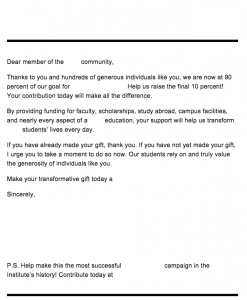
A friend of mine, who is whip-smart when it comes to nonprofit donor communications (she owns a communications firm), sent over today’s WIMI. She’s got a keen eye for uncovering the good, the bad, and the ugly on the donor communications front. Plus, she herself is a donor, and she recently forwarded me an email sent from her alma mater. She prefaced the alma mater tragedy (and I somehow doubt this is their first faux pas) with this:
“This is the kind of letter I get from my college. I loved loved loved my college experience but even when I was there I was frustrated by what they chose to spend alumni money on. This is what I get 28 years later. It’s all about them. I love the salutation.”
Her email heading dripped with incredulity. And for the record: my friend doesn’t actually love the salutation at all. That’s good old sarcasm, and trust me — it’s warranted in the case of her former college’s most recent email communication.
Dear member of the [redacted] community. Yes, really. I told you that it was warranted! See, a college’s community consists of more than current and former students. It includes parents, professors, staff, and more. So who exactly is this letter speaking to? My friend is an alum, but the letter makes no mention of this. The complete lack of personalization seeps from the salutation down into the body of the letter.
And why?
Because like she said, they’ve made it all about them — not about their donor base filled with passionate alumni who have such fond memories of their institution and feel inspired to give. Not about the current staff and professors, or the formerly employed who still feel a connection to the school and its mission.
“Why do colleges take the “make us great” approach and why does it work? Yes, I want my school to have a great reputation so it reflects well on me but this letter is so self focused it feels arrogant. I admit I love to see people’s jaws drop when I tell them where I went to school, but I paid enough money for them to have a database that can remember my name. It is so generic that it could be for any college – which is the opposite of the highly specialized institution that it is.”
What my friend has shared with me is no isolated incident, I’m afraid. If anything, this letter from [redacted] sheds some light on a disturbing trend seen all across college and university donor communications: they aren’t donor-focused at all. Whether it’s email or direct mail, whether it’s an ivy league, a state school, or an art college, this startling lack of donor-centricity consistently rears its ugly head. And it’s all the more offensive in the face of rising tuition costs.


















 I can’t wait to meet with you personally.
I can’t wait to meet with you personally.
Comments on this entry are closed.